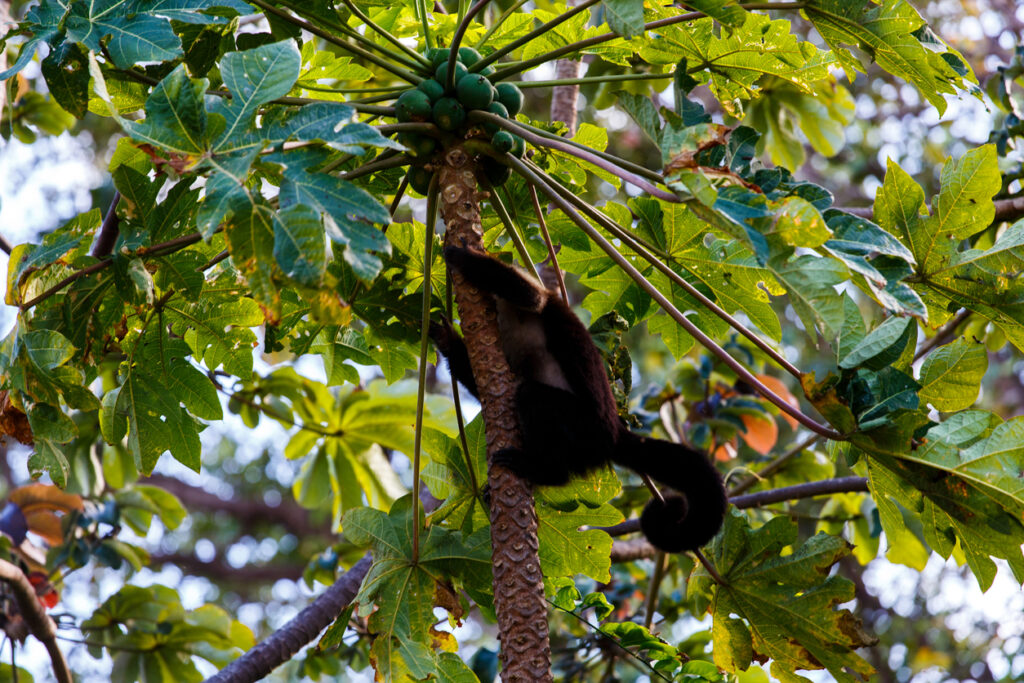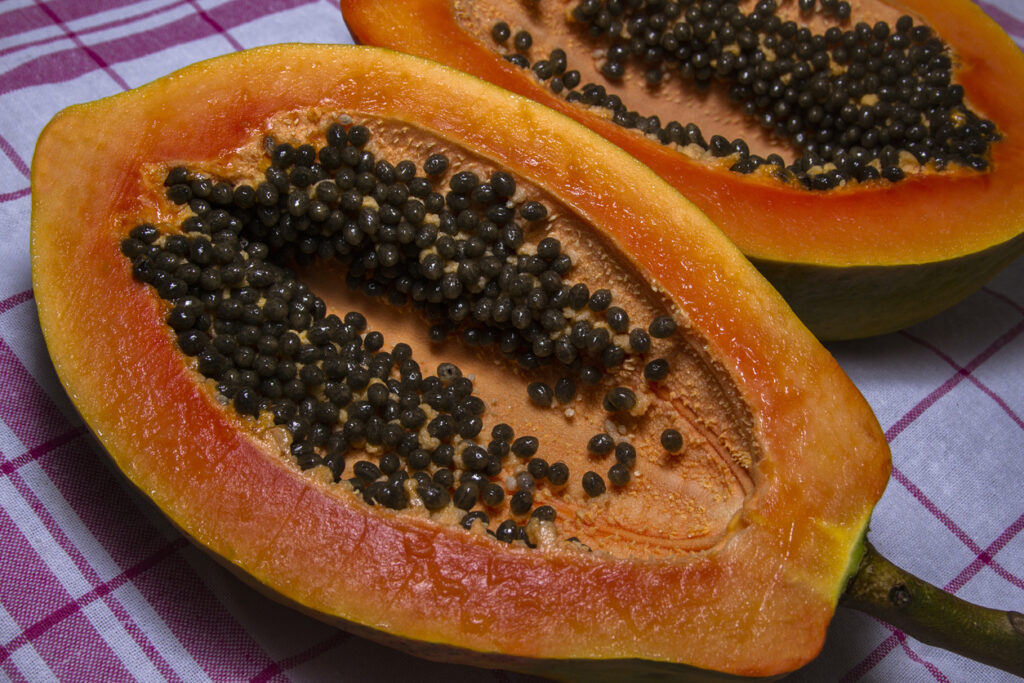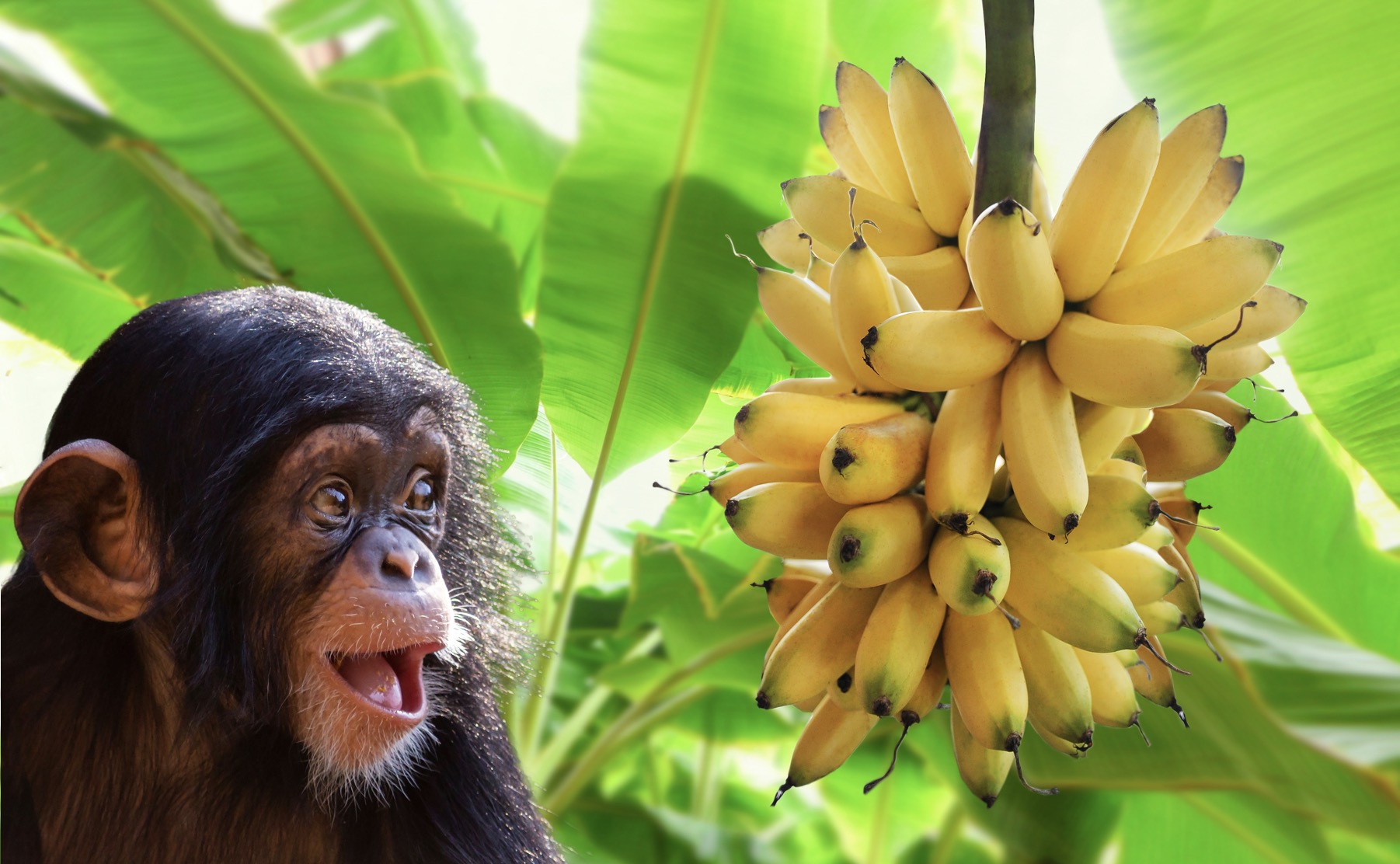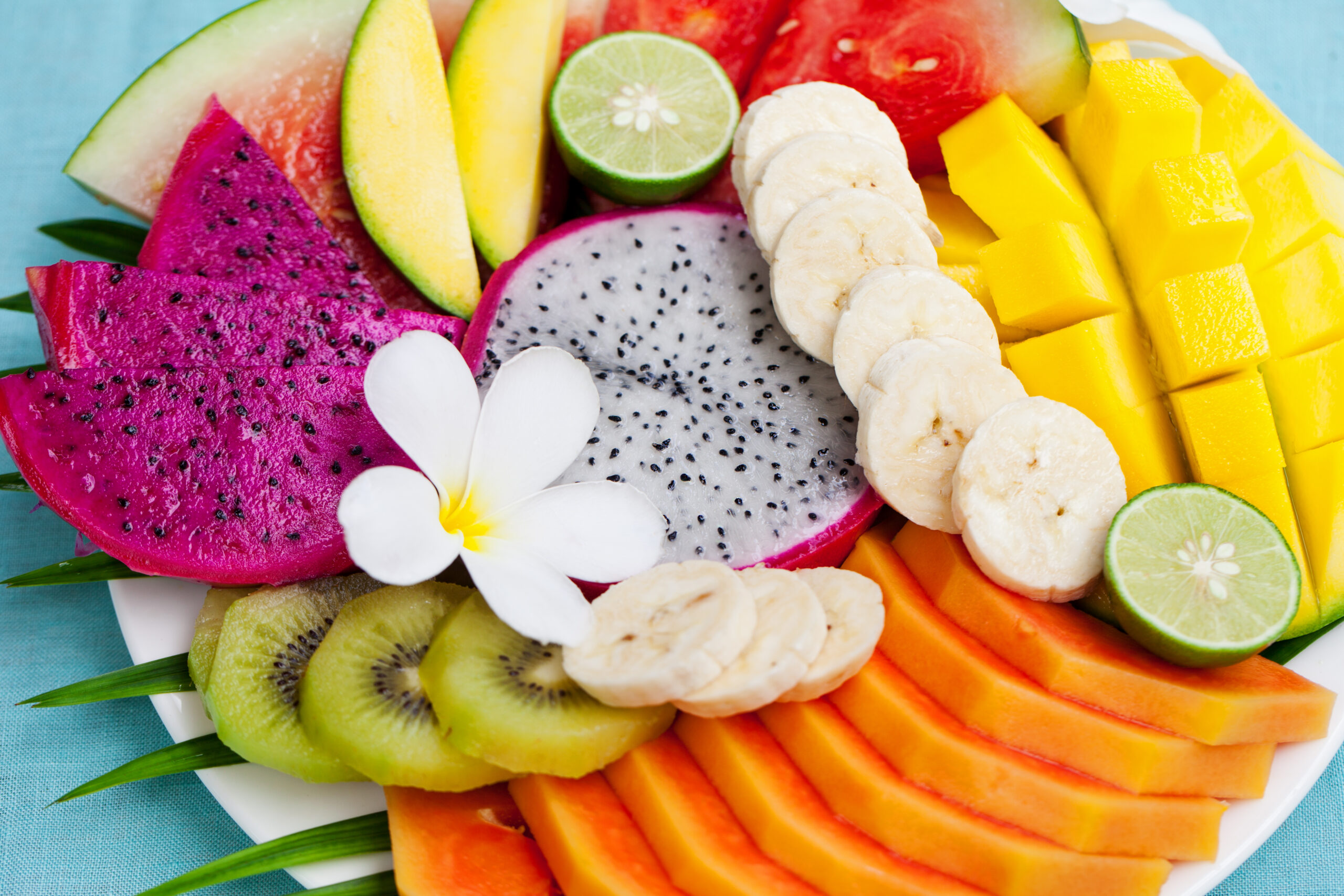Papayas (pawpaws) are not only incredibly tasty; they are incredibly healthy and nutritious – a true superfood! Or a superfruit! Papayas are also traditionally used in ethnobotanical medicine. The extraordinary benefits of tropical fruits can be attributed to the fact that they are evolutionary foods for humans. Let’s explore what science and experience teaches us…
What are Superfruits?
Papaya is a superfruit, and its benefits will leave you stunned. But let’s be clear: all edible tropical fruits are slowly being discovered as true superfoods for humans, so the term “superfruits” is being birthed into existence.
Why tropical fruits? The reason tropical fruits are so healthy lies in our evolutionary history and, therefore, in human ecology. Like all apes, humans are frugivores, species specialized in foraging and eating fruit. A diet deficient in fruit is one of the main risk factors for poor health and increased mortality (Falcomer et al., 2019). While all fruits are beneficial for human health, tropical fruits are a category on their own, with the potential to boost health to another level if consumed in abundance. Why tropical fruits? Because humans originated in tropical forests, and our ancestors are highly frugivorous, which makes tropical fruits our most important evolutionary food source! An example to illustrate the evolutionary match is the fatty acid composition in tropical fruits compared to other fruits: tropical fruits contain the perfect ratio of omega-3 to 6, while most fruits from colder climates do not – because they have evolved as food sources for birds, not primates or other mammals.

This is why eating tropical fruits in their raw, unaltered state is so delicious. Our taste buds do not lie, as they have evolved to indicate to us in nature what’s food and what’s not. Every animal in nature instinctively knows what is edible. We know it, too, if we do not let cultural filters bias our perception. Besides instincts, many more adaptations strongly suggest that humans are frugivores!
It’s not surprising that people living in the tropics are aware of the power of their fruits. They are not only occasionally used as home remedies but have a long history of medicinal uses. So, how come we still see health problems in tropical regions? Because many tropical countries do not base their traditional dishes on fruits but are often heavy in animal foods, legumes, and grains. Consuming abundant tropical fruits is the key to the myriad of health benefits, not only as an additional treat or dessert (which, of course, is better than nothing!).
Besides countless reports of people adopting a diet high in fruits to boost their health, we find a growing number of studies and evidence showing the health benefits of the beautiful fruits from the tropic paradise! In fact, there is no shortage of scientific evidence backing up what tropical indigenous people have long known!
“Tropical and subtropical fruits may be considered as a very important source of nutrients and bioactive compounds, mainly flavonoids and non-flavonoid phenolics.”
Sayago-Ayerdi et al., 2021
“These bioactive compounds (from tropical fruits) have been shown to possess various in vitro and in vivo biological activities, including antioxidant, antimicrobial, antiviral, anti-inflammatory, anti-aging, neuroprotective, and among others. Therefore, obtaining functional ingredients from tropical fruits considered exotic is viable and used to develop functional and nutraceutical foods, prepare products for the pharmaceutical industry…”
Enriquez-Valencia et al. (2020)
“The term “superfruit” has gained increasing usage and attention recently with the marketing strategy to promote the extraordinary health benefits of some exotic fruits…The phytochemicals from superfruits are bioaccessible and bioavailable in humans with promising health benefits.”
Chang et al., 2023
Just imagine what would happen if we make high-quality tropical fruits an substantial part of our diet!
Also, read our article on why temperate fruits cannot take the role of tropical fruits in our health!
What are superfoods, really?
Superfoods are commonly used to describe foods that are more nutrient-dense than “normal” foods, high in antioxidants or contain unique phytochemicals with proven health benefits. They are placed somewhere between food and medicine, which is a somewhat artificial distinction.
Not all so-called superfoods are actually superfoods! Unfortunately, many foods that are commonly referred to as superfoods (visit Harvard’s list or healthline.com’s list of superfoods) are not really the healthiest choice there is for humans. While they are nutrient-dense and provide benefits, many of those foods also contain high levels of anti-nutrients! Sally. K . Norton has dedicated a whole book (Toxic Superfoods) to the subject. Most superfoods are foods that have not been cultivated and altered as much as other common foods. This has its benefits – but also its downside: Selective breeding ensures that the harsh self-protective compounds that plants evolve towards animals are minimized. Many superfoods are foods we have not evolved to eat; thus, their harsh compounds can be tough on us. The solution is to eat nutrient-dense foods that we have actually evolved with:
True superfoods are the evolutionary food sources of humans in nature. Superfoods are species-specific foods, the foods we prefer in nature, raw, unaltered, and unprocessed foods – in the case of apes, the main evolutionary foods are fruits, nuts, and greens that are native to the tropics. These are our true superfoods, while herbs and medicinal plants are medicine.
This explains why tropical fruits are being discovered as the key to human health! Let’s start with papaya:
Superfruit papaya – Carica papaya
Papaya has a unique flavor, which is partly due to the fact that it is a high-sugar fruit and has a high content of omega-3s, aromas, and scents made up of volatile compounds like esters, aldehydes, and sulfur compounds. The trees are native to the Americas but are grown in tropical and subtropical regions around the world, including Africa, India, and Asia.
Papayas are relatively easy to transport and ripen after harvest, which fortunately makes them available in colder areas. However, if you have never had the pleasure of a tree-ripened mango from a small producer, you couldn’t know how life-transforming papayas are: you will realize that you are indeed a frugivore by nature!
Wild papayas are edible, naturally found in tropical forests, are smaller, and contain less fruit flesh than cultivated fruits. They are also loved by primates and birds.

On top of the joy of eating papayas, the fruits and other parts of the Carica papaya plant offer nearly countless benefits for human health! Mango is a highly nutrient-dense and energetic food. Orange-colored fruits are high in carotenoids, including beta-carotene (vitamin A). Papayas are also high in vitamin C, folate, vitamin E, K, copper, calcium, potassium, monounsaturated fatty acids, and omega-3s, contributing significantly to our daily nutritional needs.

Papaya contains a wealth of bioactive, antioxidant polyphenols with health-boosting and medicinal properties. Over 100 phenolic compounds have been identified, including myricetin, quercetin, kaempferol, morin, apigenin, and luteolin (Jeon et al. 2022). Besides their beneficial effects, polyphenols are also the molecules responsible for the flavor and aroma of the fruit! Papaya contains volatile compounds, which are both healthy and appealing. In this case, our biological instincts don’t mislead us when eating tasty papayas – it tastes good, it is good!
Unripe Papaya, papain, and papaya seeds should be used carefully!
Like many tropical fruits, papaya is being investigated as a source of pharmaceutical compounds. Papain has been isolated from unripe papaya and is celebrated as a digestive, anti-inflammatory supplement. However, papain is a protein present in unripe papayas. Unripe fruits usually are not meant to be consumed and contain defense molecules. Papain can cause gastritis and damage to the throat and digestive system, as well as act as an allergenic. Why? Papain is a proteolytic enzyme, which means it breaks down our body’s own proteins (not only the protein we eat), which can irritate our own tissues, in particular the tight junction proteins that are known to be decisive for leaky gut:
“Our results show that papain affects the skin barrier by increasing transepidermal water loss, degrading tight junction proteins and inducing vasodilation…From our data, we conclude that papain has all features to act as a strong allergen via the skin.”
Stremnitzer et al. (2015)
The whole fruit papaya, when underripe, contains papaya latex (the fluid obtained from the unripe fruit) with papain. This can be used to treat indigestion, parasite treatment, and wound healing – as a medicine.
Papaya seeds are widely known to treat parasites. However, the seeds are not part of the edible part of the plant. Consuming papaya seeds should be avoided as they can be toxic and, further, they are a powerful contraceptive for males – it can lead to complete loss of sperm count in monkeys (source).
The ripe papaya fruit is perfectly safe to eat in large amounts, and you will get the benefits in a safe way! Here’s a summary of the amazing benefits known to indigenous and the research that has accumulated over recent decades:
Health benefits of papayas
Some of the health benefits of papaya (the fruit itself) that have been shown in scientific studies are:
- Papaya fruit, leaf, and seeds are anti-inflammatory.
- The leaves and fruits have anti-diabetic effects.
- Papaya has antioxidant effects.
- Papaya has anti-tumor effects.
- Papaya aids digestion.
- Papaya aids with weight management and has anti-obesity effects.
- Papaya has antiviral, antibacterial, and antifungal effects.
- Papaya has anti-inflammatory and anti-arthritic effects.
- Papaya has heart-protective effects.
- Papaya has neuro-protective effects.
- Papaya has liver-protective effects
- Papaya has anti-diabetic effect.
“Carica papaya possesses numerous bioactive compounds with known pharmacological activities… such as anti-cancer, anti-inflammatory, antimicrobial, antidiarrheal, wound healing, larvicidal, anxiolytic, neuroprotective, hepatoprotective, anti-diabetic, anti-hyperlipidemic, anti-obesity, antiulcer, antithrombocytopenic, anthelminthic and contraceptive activities.”
Ugbogu et al. 2023
With so many positive effects, it is no wonder papaya is also called the “fruit of the angels” and has been used in ethnobotanical medicine for millennia. Traditional uses of papaya fruit have many applications, primarily in healing the digestive tract, infections, and tumors, and skin issues.
“Papaya is known as a “quasi-drug,” owing to its pharmaceutical properties and has been utilized as a folk medicine to heal various disorders”
Koul et al. 2022
Expand to see the references used to summarize the health benefits of papaya:
- ‘Flavour of papaya (carica papaya L.) fruit’ (2013) BIOTROPIA, 20(1). doi:10.11598/btb.2013.20.1.288.
- Chávez-Pesqueira, M. and Núñez-Farfán, J. (2017) ‘Domestication and genetics of papaya: A Review’, Frontiers in Ecology and Evolution, 5. doi:10.3389/fevo.2017.00155.
- Koul, B. et al. (2022) ‘Carica papaya L.: A tropical fruit with benefits beyond the Tropics’, Diversity, 14(8), p. 683. doi:10.3390/d14080683.
- Zhou, Y. et al. (2023) ‘Screening and characterization of phenolic compounds by LC-esi-QTOF-MS/MS and their antioxidant potentials in papaya fruit and their by-products activities’, Food Bioscience, 52, p. 102480. doi:10.1016/j.fbio.2023.102480.
- Jeon, Y.A. et al. (2022) ‘Comprehensive assessment of antioxidant and anti-inflammatory properties of papaya extracts’, Foods, 11(20), p. 3211. doi:10.3390/foods11203211.
- Mahrous, N.S. and Noseer, E.A. (2023) ‘Anticancer potential of Carica papaya Linn black seed extract against human colon cancer cell line: In vitro study’, BMC Complementary Medicine and Therapies, 23(1). doi:10.1186/s12906-023-04085-7.
- Stremnitzer, C. et al. (2015) ‘Papain degrades tight junction proteins of human keratinocytes in vitro and sensitizes C57BL/6 mice via the skin independent of its enzymatic activity or TLR4 activation’, Journal of Investigative Dermatology, 135(7), pp. 1790–1800. doi:10.1038/jid.2015.58.
- Kong, Y.R. et al. (2021) ‘Beneficial role of Carica papaya extracts and phytochemicals on oxidative stress and related diseases: A mini review’, Biology, 10(4), p. 287. doi:10.3390/biology10040287.
- Li, H. et al. (2023) ‘Characterization of green and Yellow Papaya (carica papaya) for anti-diabetic activity in liver and myoblast cells and wound-healing activity in fibroblast cells’, Nutrients, 15(8), p. 1929. doi:10.3390/nu15081929.
- Roy, J.R. et al. (2022) ‘Carica papaya reduces muscle insulin resistance via IR/Glut4 mediated signaling mechanisms in high fat diet and streptozotocin-induced type-2 diabetic rats’, Antioxidants, 11(10), p. 2081. doi:10.3390/antiox11102081.
- Ugbogu, E.A. et al. (2023) ‘Ethnomedicinal uses, nutritional composition, phytochemistry and potential health benefits of Carica papaya’, Pharmacological Research – Modern Chinese Medicine, 7, p. 100266. doi:10.1016/j.prmcm.2023.100266.
- PAPAYA (Carica papaya L.)This fruit strengthens the stomach and helps digestion. Some eat it as it comes from the tree (no date) The papaya – fruit of the angels, Europeana. Available at: https://www.europeana.eu/en/exhibitions/edible-plants-from-the-americas/papaya (Accessed: 13 December 2023).
- Koul, B. et al. (2022a) ‘Carica papaya L.: A tropical fruit with benefits beyond the Tropics’, Diversity, 14(8), p. 683. doi:10.3390/d14080683.
Let tropical fruits be thy medicine
This Superfruit series intends to show that tropical fruits are more than just a pleasant treat or dessert but build the very foundation of the natural nutrition of apes, including humans. This is reflected in the biochemical miracles that we find in fruits, which are highly beneficial and even medicinal. The compounds found in these fruits have co-evolved in a mutualistic dynamic with primates as their seed-disperser. The result is a fountain of nutrition and secondary plant metabolites biologically matched to the frugivore.
While commercialized tropical fruits have medicinal properties, many wild and underutilized fruits in tropical forests have been used as medicine by locals. Those fruits hold powerful potential to be used as medicine!
“Southeast Asian countries, including Malaysia, have tropical rainforests with a variety of fruit-bearing trees. These trees are evergreen and growing throughout the year. Many of these trees produce edible fruit for animals living within the scrubs and some of these fruits are even used by the local communities in their traditional medicine… ambarella (Spondias dulcis L.), cempedak (Artocarpus integer [Thunb.] Merr.), langsat (Lansium domesticumCorrêa), pulasan (Nephelium mutabile Blume), and salak (Salacca zalacca [Gaertn.] Voss), whereas bambangan (Mangifera pajang Kosterm.), dabai (Canarium odontophyllum Miq.), durian nyekak (Durio kutejensis Hassk. & Becc.), and some wild bananas (Musa spp.) are found mainly in the Borneo market because they are native to Borneo Island. However, some of these fruits are still collected from their wildly grown trees, and their potential medicinal properties are not well understood.”
Hock Eng Khoo et al. (2016)
Knowing our evolutionary past with tropical fruits and the plethora of beneficial biochemicals in those naturally appealing and delicious foods takes “let food be thy medicine and medicine be thy food” to another level! And I can confidently say that we should add a slightly altered version to this wisdom:
“Let tropical fruits be thy food and medicine!”
Martina Spaeni Lima
Portraying the benefits of papayas is part of the growing Superfruit series dedicated to uncovering the stunning chemical compounds in tropical fruits and their effects on health:
Other References
- Chang, S.K., Alasalvar, C. and Shahidi, F. (2018) ‘Superfruits: Phytochemicals, antioxidant efficacies, and health effects – A comprehensive review’, Critical Reviews in Food Science and Nutrition, 59(10), pp. 1580–1604. doi:10.1080/10408398.2017.1422111.
- Falcomer AL, Riquette RFR, de Lima BR, Ginani VC, Zandonadi RP. Health Benefits of Green Banana Consumption: A Systematic Review. Nutrients. 2019 May 29;11(6):1222. doi: 10.3390/nu11061222. PMID: 31146437; PMCID: PMC6627159.
- Ganguli, Barin & Narkhede, Satish & Haldankar, Parag & Bhattacharyya, Tapas. (2019). Abstract Wild Mangoes -An Incredible Wealth for Posterity. 15. 1258-1264.
- Hill, A. (2023) 16 superfoods that are worthy of the title, Healthline. Available at: https://www.healthline.com/nutrition/true-superfoods#TOC_TITLE_HDR_12 (Accessed: 16 November 2023).
- Katherine D. McManus, M. (2022) 10 superfoods to boost a healthy diet, Harvard Health. Available at: https://www.health.harvard.edu/blog/10-superfoods-to-boost-a-healthy-diet-2018082914463 (Accessed: 16 November 2023).
- Toxic superfoods, by Sally K. Norton, mph (2023) Sally K. Norton. Available at: https://sallyknorton.com/toxic_superfoods/ (Accessed: 16 November 2023).
- S. Sayago-Ayerdi, D. L. García-Martínez, A. C. Ramírez-Castillo, H. R. Ramírez-Concepción, M. Viuda-Martos, (2021) Tropical fruits and their co-products as bioactive compounds and their health effects: A Review. Foods. 10, 1952
- Enriquez-Valencia, S. et al. (2020) ‘Propiedades Bioactivas de Frutas Tropicales Exóticas y Sus Beneficios a la salud’, Archivos Latinoamericanos de Nutrición, 70(3), pp. 205–214. doi:10.37527/2020.70.3.006.
- Gunter, N.V. et al. (2020) ‘Natural xanthones and skin inflammatory diseases: Multitargeting mechanisms of action and potential application’, Frontiers in Pharmacology, 11. doi:10.3389/fphar.2020.594202.
- Khoo HE, Azlan A, Kong KW, Ismail A. Phytochemicals and Medicinal Properties of Indigenous Tropical Fruits with Potential for Commercial Development. Evid Based Complement Alternat Med. 2016;2016:7591951. doi: 10.1155/2016/7591951. Epub 2016 May 31. PMID: 27340420; PMCID: PMC4906201.




Add Comment